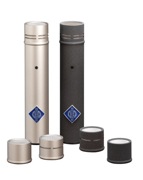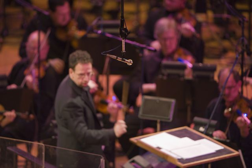Since returning to the Colorado Symphony Orchestra (CSO) to take up the position of president and CEO, Gene Sobczak has begun to modernize the organization with an ambitious program of performances featuring pop and rock artists, recordings, webcasts and educational outreach.
Resident Conductor Scott O’Neil conducting the Colorado Symphony Orchestra with a Neumann KM 133 D capturing the sound (photo credit: Darius Panahpour).
Sobczak has also forged relationships between Mike Pappas, a Denver-based recording engineer, and Sennheiser Electronic Corporation to ensure that every nuance of the orchestra is captured with innovative digital microphone technology from Neumann.
The CSO has already shared the stage this year with Trey Anastasio of the rock band Phish, Denver-based multi-instrumentalists DeVotchKa, and Boston-based alt-rockers Guster. In his role as volunteer engineer for the CSO, Pappas captured all three of these shows with an arsenal of Neumann digital microphones.
Pappas used 56 KM D series Neumann digital mics in a variety of omni-directional, cardioid and hypercardioid polar patterns. The mic list also included a Neumann KU 100 dummy head binaural stereo microphone for hall ambience, and a KMR 82 D shotgun for spot miking.
When using analog microphones and mixers, self-noise causes the noise floor to become more audible as channel counts increase. This is not the case with digital microphones however, which maintain a consistent noise floor whether one is using a single unit or three dozen units.
“In a conventional analog mic setup,” said Pappas, “mix 24 channels together and the noise floor comes up by 15 dB. Now, take 56 analog microphones and you’re looking at the noise floor coming up by 20 or 25 dB. This is significantly lower when using digital microphones. With a Neumann digital microphone you go from capsule to A-to-D converter in less than an inch. What that means is that you don’t have this low level analog signal running through hundreds and hundreds of feet of cable, and then into your preamps. In the end, all the cable does is add more noise.”
Pappas’ workflow is typically very simple: Neumann mics plugged into Neumann Digital Microphone Interface (DMIs), with the signals converted into MADI for transport to a DiGiCo mixing console for monitoring while recording into a computer running Apple Logic software. “The workflow is easier because there’s less stuff you need to worry about when you use digital mics,” Pappas said. “You plug them in, fire up the software and the system pretty much runs itself. Plus we don’t have problems with things like hums and buzzes.”

The Neumann KM D family of digital microphones features a selection of omni, cardioid and super-cardioid polar patterns.
Minnesota Public Radio (MPR), which established itself in 1967 as a classical music station, has grown to become one of the United States’ premier public radio entities and currently operates a 43-station radio network. American Public Media (APM), MPR’s parent organization, is the nation’s largest distributor of classical music programming. MPR frequently records and broadcasts the St. Paul Chamber Orchestra (SPCO) for “Performance Today,” a program that reaches 1.3 million listeners on 256 stations each week.
The SPCO is a 34-piece ensemble and the only full-time chamber orchestra in the U.S. In early April, Cameron Wiley, MPR technical director for SPCO programming, implemented an eight-channel system at a performance by the ensemble at Wooddale Church in Eden Prairie, MN. He recorded the concert to a Nuendo system using Neumann KM 183 D, KM 184 D and KM 185 D digital microphones, with the main mic array arranged in a modified Decca Tree configuration.
Since there was no rehearsal, Wiley had to take an educated guess while setting levels based on his experience recording the SPCO with his analog rig – the tympani proved troublesome. Thankfully, he recalls, the increased headroom afforded by the Neumann digital system handled the KM 143 D spot mic with no distortion. “That mic was being hit pretty hard, but it handled this very well. If we had used analog, it wouldn’t have survived those levels.”
